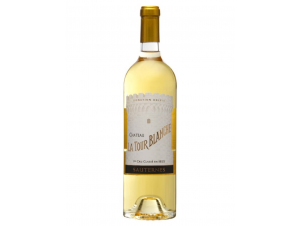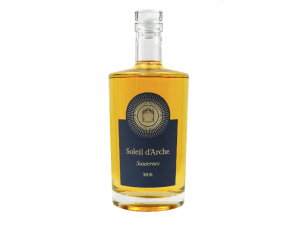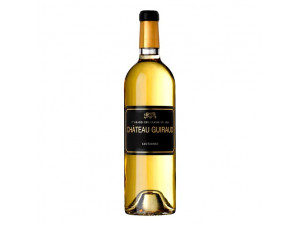You have no items in your shopping cart.
Wine Sauternes
Located on the left bank of the Gironde, the area of this appellation d'origine contrôlée is composed of five communes: Barsac, Bommes, Fargues Preignac and Sauternes. The vineyards, dating back to Roman times, produce great wines, renowned throughout the world. Many legends surround the birth of this wine and give it a mysterious character. Read more on Sauternes
-
Top Selling
-
Top Selling
-
Top Selling
- -30%
Appellation Sauternes
Sauternes is a wine of legend
The rumours surrounding the birth of Sauternes are numerous. Notably, in 1836, a Bordeaux wine merchant by the name of Focke, was said to have been forced to start his vendanges very late, due to bad weather, and it was the food of the over-ripe grapes that was said to have given birth, through a mysterious alchemical work, to the divine nectar of Sauternes. Or again, in 1847, the Marquis of Lur-Saluce, who had gone hunting in Russia, had given the order not to harvest before his return. The noble rot, formed on the grapes of his vineyard during this wait, gave birth to the exceptional wine.
In the 17th century, Dutch merchants encouraged the production of sweet white wines which they loved. It was precisely a Dutch naturalist who first identified the Botrytis cinerea, the fungus responsible for the mysterious transformation of Sauternes wines into sweet wines. But it was not until the 18th century that we had written proof, in a letter from 1741, of the use of noble rot in wine production. We also know that Thomas Jefferson, a great wine lover and future President of the United States, tasted Sauternes in May 1787. That same year he ordered thirty twelve-bottle cases of Yquem for President Washington.
In the 19th century, the success was immense. In 1859, the Grand Duke Constantine paid 20,000 francs for a barrel of Château Yquem, vintage 1847. The appellation of controlled origin Sauternes was recognised by decree on 30 September 1936. It should be noted that the wines of Barsac are part of the Sauternes AOC.
Sauternes is a sweet wine renowned throughout the world
Located about 40 kilometres from Bordeaux, on the left bank of the Gironde, the appellation area is bounded to the east by the Garonne valley, to the west by the Ciron, and by the Landes forest which forms a protective barrier to the east and south. These 2200 hectares of vines include 250 estates and 26 classified growths.
The thermal shock caused by the meeting of the river Ciron, and its cold waters, and the warmer waters of the Garonne, causes morning mists which favour the development of Botrytis cinerea. It creates the noble rot that allows the production of Sauternes, and it is essential to its manufacture. The microclimate, very favourable to the vineyards, is protected by the forest. The vineyard is generally composed of 80% Semillon, 15% Sauvignon and 5% Muscadelle. Semillon, which is over four centuries old, is the typical Sauternes grape variety.
It is also very resistant to mildew, but its yields are uncertain, as excess rainfall is harmful to it. Harvesting is done by hand and in several selections, as the overripe grapes. Yields are limited to a maximum of 25 hectares per litre, 8 hectares per litre at Yquem. The fermentation lasts between 3 and 4 weeks, and the maturation is carried out in barrels over a period that varies between 12 and 18 months.
The soils are characterised by gravelly croups and clay-limestone subsoils. Very white, they catch the sun's rays and release them at night. Yquem is located on a high terrace of clay-gravel nature 70 to 80 metres high, on the edge of the Landes. Further down, a 40 to 70 metre terrace, made up of Gronnaises Günzian and Mindelian gravel, produces the majority of the grands crus of the AOC. Finally, a low sandy terrace also hosts vineyards between Preignac and Barsac, along the river. On the left bank of the Ciron is the limestone plateau of Haut-Barsac.
Sauternes is a golden-coloured nectar
Gold wonderfully dominates the colour of Sauternes wine, and it takes on a beautiful amber colour with age. Its nose is complex and it develops aromas of citrus, quince, almond, sloe, dried apricot, roasted peach, passion fruit. To this are added floral notes of lime, acacia, mimosa, honeysuckle, with some touches of beeswax and hazelnut.
On the palate, it is fine and fat, and immediately expresses its power. The honey and toast-tinged candied notes give way to white flowers and fruit, such as apricot, and a musky flavour can be felt.
The keeping potential of Sauternes wine is exceptional, from 5 to 50 years depending on the year. It is a wonderful match for foie gras, pan-fried or in terrine, white meats, fine fish, but also cheeses and desserts.
Let's discover 3 exceptional classified growths of the Sauternes AOC
Château d'Yquem: premier cru supérieur
It is Romain-Bertrand de Lur-Saluces, grandson of Françoise-Joséphine who obtains this premier cru supérieur au classement de 1855 classification. The estate is designated as the only premier cru supérieur in the classification established by Emperor Napoleon III on the occasion of the Universal Exhibition. Renowned throughout Europe, it was appreciated by crowned heads such as the Grand Duke Constantine, brother of the Tsar. Yquem did not escape the phylloxera crisis and the Great War, but resumed its exceptional rise as soon as peace returned.It is in the respect of the traditional know-how that the domain has been able to maintain its prosperity throughout the ages. The plots have remained the same for nearly two centuries and are cultivated without ever yielding to the temptation to use chemicals. Each harvest is produced with respect for the natural ecosystems. Moreover, the estate has had its own weather station since 1896. The great care taken in the production of the wine can be seen in the many vintages that the estate can boast of.
Château Climens: premier grand cru
For five centuries, the know-how and knowledge of wine has been passed down from generation to generation. Indeed, the name Climens appears for the first time in a contract in 1547. For two and a half centuries, the Roborel de Climens family developed the vineyard and ensured its prosperity. The structure and surface area have remained intact for at least two centuries. The property was damaged during the French Revolution and was sold to a Bordeaux merchant, also a seasoned winegrower, in 1802 by the name of Jean Binaud. Naturally, the estate was classified as a First Growth in the 1855 classification.In the early 1970s it was bought by Lucien Lurton, owner of prestigious classified growths in the Médoc appellation and passed on to his daughter, Bérénice Lurton, in 1992. Still in charge of the property, she scrupulously watches over the quality of the selections, the blending of the barrels, and checks all the other stages of the process herself. Numerous vintages reward all these efforts, notably 2011, which is characterised by its refinement.
Château La Tour Blanche: premier grand cru
The estate was founded by a councillor at the Bordeaux Parliament, Monsieur de Latour Blanche at the end of the 18th century. It was taken over by the famous Focke, who is credited with the discovery of Botrytis cinerea. It then passed into the hands of Pierre Pécherie during the Revolution. The cru was classified in 1855, first on the list behind Yquem. In 1876, Daniel Iffla took over the reins of the estate, which he bequeathed to the State, on condition that the latter founded a free school of viticulture there. The vineyard was then managed by the Regional Council of Aquitaine.
Bordeaux appellations










































 TWIL - Achat de Vin
TWIL - Achat de Vin


